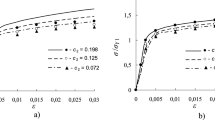Abstract
The analysis of the constraint equations for strain deviator and V. V. Novozhilov stress deviator that contain uncertainty in the form of an additional characteristic, which is called the similarity phase of deviators is performed. This additional characteristic is a limitation of direct use of these equations for processing the experimental data. The transformation of the equations has allowed us to give the material functions a physical meaning of the shift characteristics in areas with main tangential stresses and to find relations for the generalized shear modulus and phase, which remove the indicated limitation and allow reflecting the effect of form change on bulk deformation and their interdependence.
The transformation of the initial equations, which include the constraint equation for average strain and stress tensor invariants, is reduced to the form that is characteristic for the equations of an anisotropic medium. Transformed equations make it possible to find another form of the equation for the average (bulk) deformation. This mathematical apparatus has allowed us to develop a method for determining all the characteristics of elasticity, including moduli and compliances that are capable to reflect the loosening effect due to the breaking of bonds and changing of the interaction between the elements of structure of composite materials, as well as the changing of elasticity.
Using the initial values of the bulk elasticity moduli, called “apparent” ones, since they characterize not the stiffness of the medium, but its change, three parameters of varying elasticity are determined. They are the ratio of the “classical” modulus assumed to be constant, when the average strain changes, to the “apparent” moduli. They make it possible to estimate the resulting deformation anisotropy and elasticity, which is preserved and acquired as a result of a change in the state of the bonds.
To verify the proposed method, the comparison of the calculations for the elastic and additional (dilatancy) parts of the bulk deformation according to the initial equation and equation found after the transformation that includes the compliance of the bulk elasticity and the loosening parameter with the experimental data has been performed. It has been shown that the obtained theoretical results are in a good agreement with experimental ones. Moreover, It has been stressed out that the loosening effect is the main and only reason for the change in elasticity, multimodularity, and anisotropy.
Similar content being viewed by others
References
J. F. Bell, Experimental Foundations of Solid Mechanics (Springer, Berlin—Heidelberg—New York, 1973; Nauka, Moscow, 1984).
V. V. Novozhilov, “On the Relation between Stresses and Strains in Nonlinearly Elastic Medium,” Prikl. Mat. Mekh. 15 (2), 183–194 (1951) [J. Appl. Math. Mech. (Engl. Transi.)].
E.V. Lomakin, “Mechanics of Media with Stress-State-Dependent Properties,” Phys. Mesomekh. 10(5), 41–52 (2007). [Phys. Mesomech. (Engl. Transi.) 10(5–6), 255–264 (2007)].
A. Nadai, Theory of Flow and Fracture of Solids, Vol. 2 (McCraw-Hill Bool Comp., Inc., New York-Toronto—London, 1963; Izd-vo Inostr. Lit., Moscow, 1969).
K. F. Komkov, “Peculiarities of Elastic Properties of Highly Filled Polymer Materials,” Vestnik MGTU im. Baumana Ser. Mashinostr. No. 3, 3–13 (2008).
A. N. Eremichev, “Complex Tests for Estimation of Mechanical Properties of High-Filled Polymers,” Inzh. Vestnik, No. 9, 17–32 (2014).
K. F. Komkov, “On the Tensor Nonlinearity of Media Exhibiting a Significant Difference in Resistance to Tension and Compression,” Elektr. Zh., No. 10 (2013) DOI: 10.7463/0513.0571202.
S. G. Lekhnitskii, Theory of Elasticity of an Anisotropic Body (Nauka, Moscow, 1977) [in Russian]
Acknowledgments
The author is grateful to N. F. Morozov (Academican), who noted the usefulness and necessity of research on the development of V. V. Novozhilov ideas, O. G. Rybakina (Professor) for useful comments concerning this article, and A. N. Yeremichev (Associate Professor, Bauman Moscow State Technical University) for the recommended experimental studies that had an impact on the article results.
Author information
Authors and Affiliations
Corresponding author
Additional information
Russian Text © The Author(s), 2019, published in Izvestiya Akademii Nauk, Mekhanika Tverdogo Tela, 2019, No. 1, pp. 50–62.
About this article
Cite this article
Komkov, K.F. Development of the Method for Determining the Modulus of Bulk Elasticity and Parameters Taking Into Account the Loosening and Changing of the Elasticity of Composites by Using the Tensor—Nonlinear Equations. Mech. Solids 54, 39–49 (2019). https://doi.org/10.3103/S0025654419010035
Received:
Published:
Issue Date:
DOI: https://doi.org/10.3103/S0025654419010035




